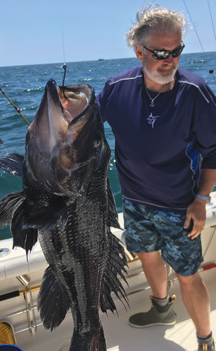It was Monday July 5th. With the holiday weekend over and Dave wanting to scout areas to the north, it was time to hang the lines and head out. We drifted for bottom fish in a few different north side areas using fluke and porgy rigs without any edible units, my nickname for keeper size fish. When the decision was made to go off the south side to a known hotspot it was time to switch it up. I grabbed a spool of 40lb mono leader and built my own rig instead of store bought ones.
Lately, I’ve been thinking about the art of fishing. I tie a dropper loop first using about about 3 feet of leader material for the rig. Then I tie a sinker loop. Then I look at how much I had left to work with. I clipped my bottom dropper. Now it was one line to tie a 5/0 gamakatsu hook to. It made for a longer line to the hook off the mainline than the dropper loop would be. I tied the bottom hook to it with the 3 up 2 down knot. The art of fishing was at work. With the extra mainline I tied a dropper loop in between the bottom hook and top of the rig.
I put a 5/0 gamakatsu on the upper dropper loop. Finally, I tie a swivel to the top of the rig so it doesn’t get “spun up”. A nickname for a tangled rig because it was spinning without a swivel. I was excited to try the two hook handmade rig. It’s a pinhooker special for catching Black Sea Bass. Pinhooker is the name for commercial rod and reel fishermen. A 5/0 hook was bigger than what was on the store rigs. I loaded both hooks with clam, hoping the bigger hooks would produce bigger fish. When we drifted over fish I was hooked up regularly with many doubleheaders. I built another double hook rig for Dave and switched him to a braided rod and reel. You feel every bite with braid.
 Over 20 years ago I was pulling for some friends. Pulling is a term used for catching fish commercially on rod and reel. I was told to use braid while blackfishing if I wanted to be part of the crew. Now with both of us using braid set-ups with my double dropper rigs it was one doubleheader after another. Only one problem, most fish were 13-14 inches and in NY Atlantic Black Sea Bass need to be 15 inches to keep recreationally. All of a sudden we hit an area full of “knotheads”, a nickname for big male black sea bass.
Over 20 years ago I was pulling for some friends. Pulling is a term used for catching fish commercially on rod and reel. I was told to use braid while blackfishing if I wanted to be part of the crew. Now with both of us using braid set-ups with my double dropper rigs it was one doubleheader after another. Only one problem, most fish were 13-14 inches and in NY Atlantic Black Sea Bass need to be 15 inches to keep recreationally. All of a sudden we hit an area full of “knotheads”, a nickname for big male black sea bass.
Atlantic Black Sea Bass are protogynous hermaphrodites. They start life as females and turn into males for spawning. Big males have distinct bumps on their four heads, thus the “knot head” moniker. They also have longer tails, especially in the middle of the tail where it counts when measuring. I came up with the saying, “it was the tail, that killed the male”. As the keepers came in, I clipped a gill and tossed them in a five gallon bucket with a saltwater ice brine. Between drifts, after they bled out, I buried them in a cooler full of ice.
Later at the fillet table the meat was powder white. In my opinion Atlantic Black Sea Bass is our best eating local fish. I’ve always been fascinated by the creamy oil left on my hands when cutting and handling fillets. I love the way the fillets flake into succulent sections when cooked.
I cut fillets into 3-4 inch pieces and bake them with fresh vegetables, garlic and oil. I named one of my recipes Sea Bass Mediterranean. I cook the cut sea bass chunks with small broccoli florets, garlic, olive oil and fresh herbs. I cover them in a Pyrex plate with crumbled feta cheese and seasoned bread crumbs. Bake it at 420° for 15-20 minutes and enjoy with lemon sections. Mangia!

